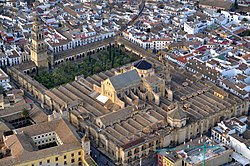Mesquita-Catedral de Córdova
Hoje, Mesquita-Catedral de Córdova é um tema que continua a gerar interesse e debate na sociedade. Durante décadas, Mesquita-Catedral de Córdova se posicionou como um tema de relevância em diversas áreas, da política à cultura popular. Ao longo do tempo, Mesquita-Catedral de Córdova evoluiu e adquiriu novos significados e nuances, o que contribuiu para que continuasse a ser objeto de estudo e investigação em diversas disciplinas. Neste artigo exploraremos diferentes aspectos relacionados a Mesquita-Catedral de Córdova, analisando seu impacto e relevância hoje.
| Tipo |
|---|
| Comprimento |
178 m |
|---|---|
| Largura |
125 m |
| Composto de |
Q16553114 Capilla Mayor, Mosque-Cathedral of Córdoba (d) Capilla de Villaviciosa, Mosque-Cathedral of Córdoba (d) Capela de Nossa Senhora da Conceição (Mesquita-Catedral de Córdova) (d) Capilla de San Acacio, Mosque-Cathedral of Córdoba (d) Capilla de San Ambrosio, Mosque-Cathedral of Córdoba (d) Capilla de los Santos Simón y Judas, Mosque-Cathedral of Córdoba (d) |
| Data |
|---|
| Estatuto patrimonial |
|---|

A Mesquita-Catedral de Córdova[1][2] oficialmente conhecida pelo seu nome eclesiástico, a Catedral de Nossa Senhora da Assunção (em espanhol: Catedral de Nuestra Señora de la Asunción)[3] é a catedral da Diocese Católica Romana de Córdoba dedicada à Assunção de Maria e localizado na região espanhola da Andaluzia.[4] Devido ao seu status como uma antiga mesquita islâmica, também é conhecida como Mesquita[5][6] e como a Grande Mesquita de Córdova (Espanhol: Mezquita de Córdoba).[7][2][8]
Ver também
Referências
- ↑ «Web Oficial del Conjunto Monumental Mezquita-Catedral de Córdoba». Consultado em 15 de agosto de 2016
- ↑ a b «Mosque-Cathedral of Córdoba». Encyclopædia Britannica, Inc. Consultado em 15 de agosto de 2016
- ↑ 100 Countries, 5,000 Ideas. : National Geographic Society. 2011. p. 299. ISBN 9781426207587.
The eight-century Great Mosque with double arches in Córdoba was transformed into the Cathedral of our Lady of Assumption.
- ↑ Daniel, Ben (2013). The Search for Truth about Islam. : Westminster John Knox Press. p. 93. ISBN 9780664237059.
The church is Catholic and has been for centuries, but when Catholic Spaniards expelled the local Arabic and Muslim population (the people they called the Moors) in 1236, they didn't do what the Catholic Church tended to do everywhere else when it moved in and displaced locally held religious beliefs: they didn't destroy the local religious shrine and build a cathedral of the foundations of the sacred space that had been knocked down. Instead, they built a church inside and up through the roof of the mosque, and then dedicated the entire space to Our Lady of the Assumption and made it the cathedral for the Diocese of Córdoba.
- ↑ Andrew Petersen (11 de março de 2002). Dictionary of Islamic Architecture. : Routledge. p. 55. ISBN 978-1-134-61365-6
- ↑ Lawrence S. Cunningham; John J. Reich; Lois Fichner-Rathus (14 de setembro de 2016). Culture and Values: A Survey of the Humanities, Volume I. : Cengage Learning. p. 262. ISBN 978-1-337-51494-1
- ↑ «Historic Centre of Cordoba». UNESCO. Consultado em 17 de agosto de 2016.
The Great Mosque of Cordoba was inscribed on the World Heritage List in 1984
- ↑ Lapunzina, Alejandro (2005). Architecture of Spain. : Greenwood Publishing Group. p. 81. ISBN 9780313319631

